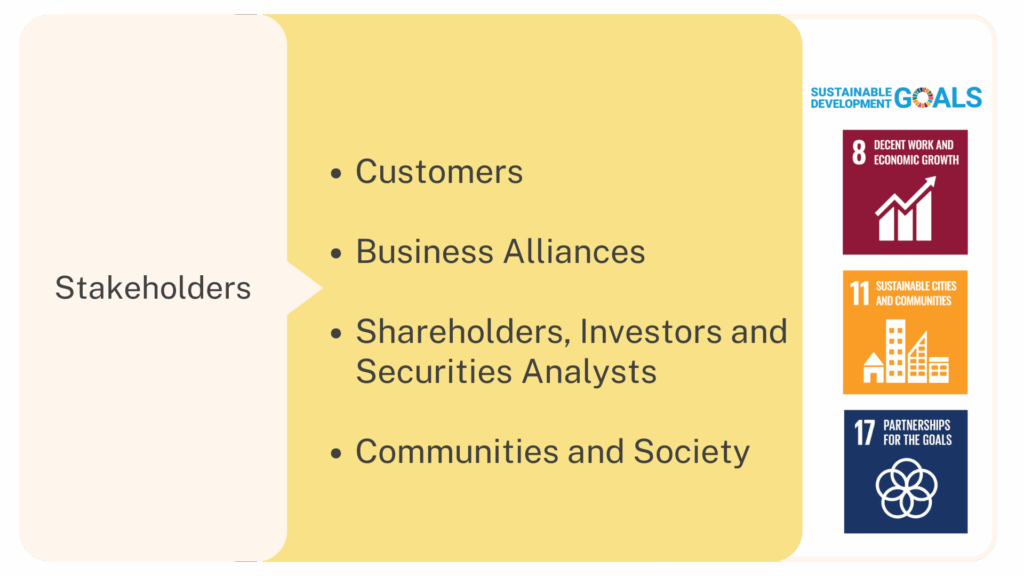
Importance
Airport infrastructure and capacity are critical to AOT’s business operations, serving as the foundation for revenue generation and long-term sustainable growth. In particular, the development of airports to accommodate future expansion in the aviation industry—including passenger traffic, cargo, and service operations—is essential. Appropriate infrastructure development enhances operational efficiency, reduces costs, and strengthens AOT’s competitive advantage. Furthermore, it increases the company’s potential to generate revenue from both aeronautical and non-aeronautical activities.
AOT emphasizes managing airport capacity by developing infrastructure and airport facilities, with a focus on leveraging digital technologies to meet the evolving needs of passengers, airlines, and service users efficiently. These efforts have a direct impact on customers and operational partners, and an indirect influence on local communities, society, and the media. Effective infrastructure management enhances the overall passenger experience and satisfaction among airlines and airport operators, thereby enabling AOT to deliver high-quality services and build trust across all stakeholder groups.
Moreover, improving service quality not only helps attract investors and create new business opportunities but also fosters collaboration between AOT and its partners. This goes hand in hand with building resilient infrastructure, which contributes to societal value creation, such as job creation. At the same time, media outlets can disseminate news related to AOT’s business activities, which are of broad public interest, thereby strengthening the organization’s image and enhancing stakeholder confidence in AOT.
Management Approach
AOT operates in alignment with its strategic and operational plans, as well as related guidelines, to expand the airport’s service capacity and business development in pursuit of continuous and holistic sustainable development that meets the expectations of all stakeholders. The organization’s goal is to enhance both internal and external capacity to achieve its vision of becoming a “World-Class Airport Operator,” which is articulated in its corporate vision:
“AOT as a world-class airport operator and manager: committed to service quality with an emphasis on safety and balanced revenue generation.”
This is supported by AOT’s mission to:
“Operate and promote airport businesses, along with related or supporting activities, with consideration for sustainable development.”
To achieve this goal, AOT has implemented three core plans:
- AOT Corporate Plan (Fiscal Years 2023–2027, revised edition for FY2024)
- Airport Development Master Plans for all six airports under AOT’s responsibility, to increase capacity in response to growing air traffic demand
- AOT International Business Development Master Plan (FY2018–2024), aimed at enhancing AOT’s business capabilities through international cooperation and trade association engagement aligned with AOT’s strategic direction
AOT Corporate Plan for Fiscal Years 2023–2027 (Revised Edition for FY2024)
AOT has formulated its operational plans under the AOT Corporate Plan for Fiscal Years 2023–2027 (Revised Edition for FY2024) – SMILE, which serves as a strategic framework for achieving sustainable growth and enhancing service excellence across all airports under its responsibility.
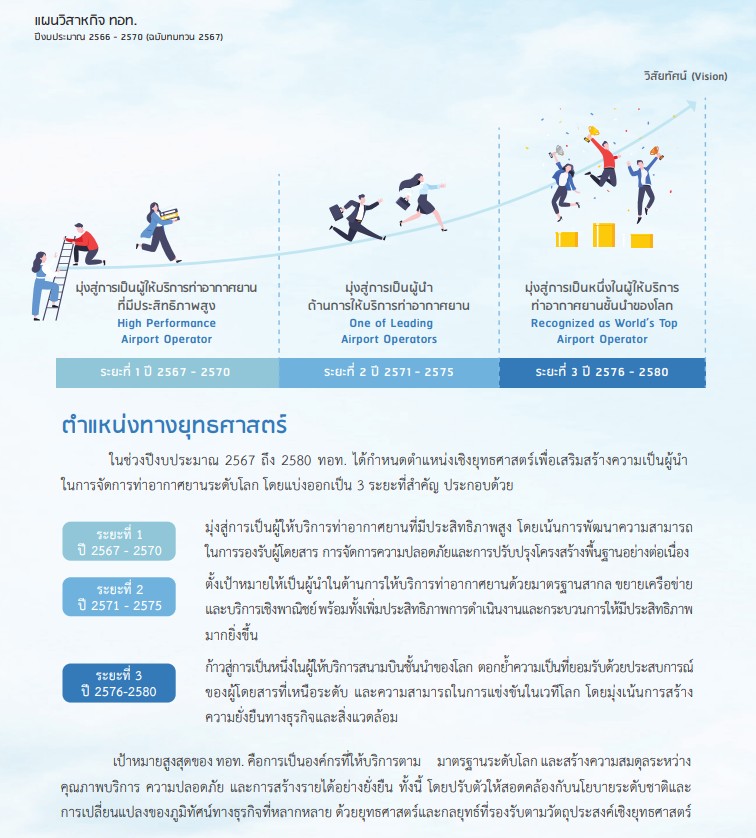
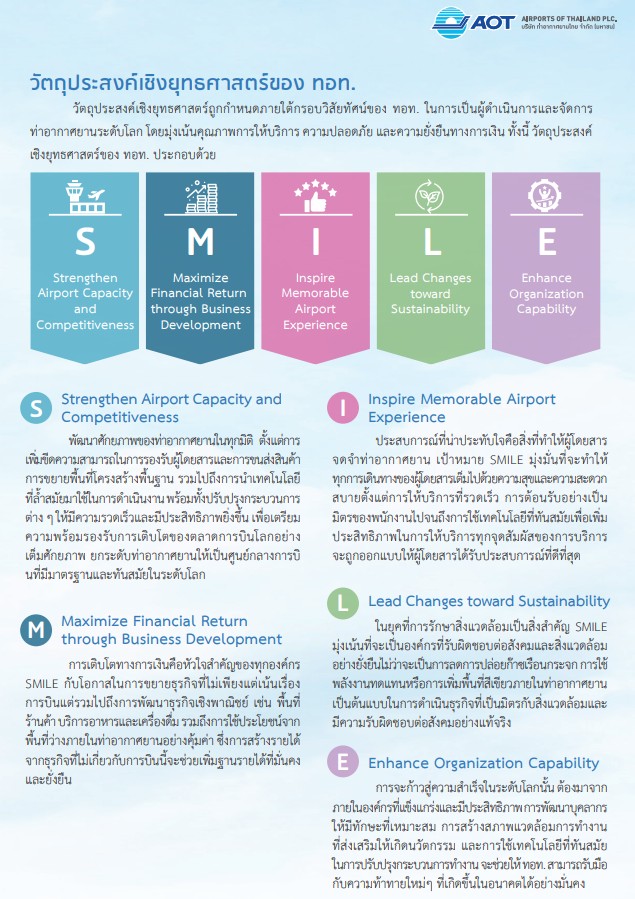
Strategic objective-level indicators and corresponding targets have been established to enhance airport capacity and expand business opportunities, in alignment with two strategic objectives: SO1 and SO2, as detailed below.
| KPI | Performance | Target | ||||
|---|---|---|---|---|---|---|
| 2567 | 2567 | 2568 | 2569 | 2570 | ||
| SO1: Enhance airport capacity and capabilities to accommodate the growth in passenger and air cargo traffic in compliance with international safety and security standards. (Strengthen Airport Capacity and Competitiveness) | ||||||
| 1. Total Passenger Handling Capacity (persons/year) | 116 | 116 | 116 | 116 | 116 | |
| 2. Air Cargo Handling Capacity of Suvarnabhumi Airport (tons/year) | 1.7 | 1.7 | 1.7 | 1.7 | 1.7 | |
| SO2: Increase passenger volume through marketing activities and strategic partnerships to expand flight routes and airline connectivity. In parallel, develop non-aeronautical businesses to diversify and expand AOT’s overall revenue base. (Maximize Financial Return through Business Development) | ||||||
| 1. Total Passenger Volume (persons/year) | 119.29 | 120 | 130 | 140 | 150 | |
| 2. Total Aircraft Movements (flights/year) | 732,688 | 755,429 | 806,569 | 856,679 | 905,761 | |
| 3. Air Cargo Throughput at Suvarnabhumi Airport (tons/year) | 1.33 | >1.30 | >1.40 | >1.50 | >1.60 | |
| 4. Cargo Terminal Utilization Rate at Suvarnabhumi Airport (%) | 78 | 76 | 82 | 88 | 95 | |
| 5. Percentage of Non-Aeronautical Revenue to Total Operating Revenue (%) | 54 | 55 | 55 | 55 | 55 | |
To support the organization’s strategic direction, AOT has established strategic-level key performance indicators (KPIs) as outlined below.

| KPI | Performance 2024 | Target | ||||||||
|---|---|---|---|---|---|---|---|---|---|---|
| 2024 | 2025 | 2026 | 2027 | |||||||
| Strategy 1: Expand Passenger Handling Capacity in Compliance with Airport Safety and Security Standards | ||||||||||
| Strategy 1.1: Develop Airport Infrastructure in Compliance with Safety and Security Standards | ||||||||||
| 1. Passenger Handling Capacity by Airport (million persons/year) | ||||||||||
| Suvarnabhumi Airport | 60 | 60 | 60 | 60 | 60 | |||||
| Don Mueang International Airport | 30 | 30 | 30 | 30 | 30 | |||||
| Phuket International Airport | 12.5 | 12.5 | 12.5 | 12.5 | 12.5 | |||||
| Chiang Mai International Airport | 8 | 8 | 8 | 8 | 8 | |||||
| Mae Fah Luang – Chiang Rai International Airport | 2.5 | 2.5 | 2.5 | 2.5 | 2.5 | |||||
| Hat Yai International Airport | 3 | 3 | 3 | 3 | 3 | |||||
| 2. Achievement Rate of Airport Development Plan Implementation (%) | ||||||||||
| Suvarnabhumi Airport | 100 | 100 | 100 | 100 | 100 | |||||
| Don Mueang International Airport | 100 | 100 | 100 | 100 | 100 | |||||
| Chiang Mai International Airport | 100 | 100 | 100 | 100 | 100 | |||||
| Strategy 1.2: Enhance the Efficiency of Airport Infrastructure Utilization | ||||||||||
| 1. Runway Accidents (cases) | 0 | 0 | 0 | 0 | 0 | |||||
| 2. Percentile of Hourly Passenger Service Volume Compared to Design Capacity – BKK and DMK | 95th Percentile (Annual) | 94th Percentile (Annual) | 95th Percentile (Annual) | 95th Percentile (Annual) | 95th Percentile (Annual) | |||||
| 3. Minimum Connecting Time (MCT) at Suvarnabhumi Airport (minutes) | 75 | 75 | 75 | 75 | 75 | |||||
| Strategy 2: Enhance Air Cargo and Freight Handling Capacity | ||||||||||
| Strategy 2.1: Develop Infrastructure Related to Air Cargo Operations | ||||||||||
| 1. Achievement Rate of the Air Cargo Capacity Enhancement Plan at Suvarnabhumi Airport (%) | No Plan | 100 | 100 | 100 | 100 | |||||
| Strategy 3: Enhance Aeronautical Operations | ||||||||||
| Strategy 3.1: Develop Proactive Air Route Marketing Strategies | ||||||||||
| 1. Passenger Volume by Airport (million persons/year) | ||||||||||
| Suvarnabhumi Airport | 60.00 | 59.68 | 64.44 | 69.11 | 73.68 | |||||
| Don Mueang International Airport | 29.15 | 30.57 | 33.33 | 36.03 | 38.68 | |||||
| Phuket International Airport | 16.39 | 14.58 | 16.00 | 17.39 | 18.76 | |||||
| Chiang Mai International Airport | 8.82 | 9.24 | 10.01 | 10.76 | 11.50 | |||||
| Mae Fah Luang – Chiang Rai International Airport | 3.03 | 3.46 | 3.69 | 3.93 | 4.15 | |||||
| Hat Yai International Airport | 1.90 | 2.26 | 2.49 | 2.73 | 2.95 | |||||
| 2. Aircraft Movements by Airport (flights/year) | ||||||||||
| Suvarnabhumi Airport | 346,678 | 355,892 | 376,818 | 397,323 | 417,407 | |||||
| Don Mueang International Airport | 197,520 | 208,292 | 223,725 | 238,847 | 253,658 | |||||
| Phuket International Airport | 98,711 | 90,392 | 97,692 | 104,845 | 111,851 | |||||
| Chiang Mai International Airport | 57,783 | 64,504 | 69,210 | 73,821 | 78,337 | |||||
| Mae Fah Luang – Chiang Rai International Airport | 19,731 | 22,492 | 23,819 | 25,120 | 26,394 | |||||
| Hat Yai International Airport | 12,263 | 13,857 | 15,305 | 16,724 | 18,114 | |||||
| Strategy 5: Improve Service Processes and Quality to Enhance Operational Efficiency and Stakeholder Satisfaction | ||||||||||
| Strategy 5.2: Leverage Technology to Enhance the Customer Experience | ||||||||||
| 1. Percentage of Passengers Using Installed Technologies (%) | ||||||||||
| 1.1 Common Use Self-Service (CUSS) Check-in System | ||||||||||
| • Suvarnabhumi Airport | 27 | ≥25 | ≥25 | ≥25 | ≥25 | |||||
| • Don Mueang International Airport | 20 | 18 | 20 | 22 | ≥25 | |||||
| • Chiang Mai International Airport | 12.23 | 18 | 20 | 22 | ≥25 | |||||
| 1.2 Common Use Bag Drop (CUBD) System | ||||||||||
| • Suvarnabhumi Airport | 18.39 | 12 | 17 | 22 | ≥25 | |||||
Infrastructure and Capacity Development Action Plan
Under the AOT Corporate Plan for Fiscal Years 2023–2027 (Revised Edition for FY2024), AOT conducted an assessment of its Action Plan for FY2024 based on AOT’s internal criteria for evaluating and selecting action plans. The assessment identified key operational initiatives that are aligned with and contribute to the organization’s strategic indicators and targets. These initiatives have been selected as part of AOT’s official Action Plan for Fiscal Years 2024–2025, as outlined below.
| Plans |
|---|
|

The integration of these two strategic components enables AOT to enhance passenger access to services while maintaining international standards in airport business management. The approach emphasizes strengthening economic, environmental, and social performance.
AOT’s business development efforts are focused on two main areas:
| 🤝 | |
|---|---|
| Internal Capacity | External Capacity |
| Focus on the development of infrastructure, personnel, and internal operational systems. | Focus on building partnerships and responding to opportunities arising from the external environment. |
Airport Accessibility and Business Opportunity from Internal Development

Expansion of Airport Capacity Under AOT’s Airport Development Master Plan for Optimized Passenger Service Management
AOT has developed an Airport Development Master Plan to support the strategic expansion of airport capacity, with the objective of achieving optimal efficiency in passenger service management. This master plan is aligned with Thailand’s 20-Year National Strategy and has been approved by the AOT Board of Directors, the Ministry of Transport, the Office of the National Economic and Social Development Council (NESDC), and the Cabinet.
The Airport Development Planning Department, under the Engineering and Construction Group, is responsible for overseeing the implementation of the capacity enhancement efforts across all six AOT-operated airports. The master plan is regularly monitored and reviewed to ensure alignment with changing aviation industry dynamics and the successful achievement of long-term development goals.
Currently, AOT has established long-term airport development targets under this master plan through the year 2040 (B.E. 2583), as outlined below.
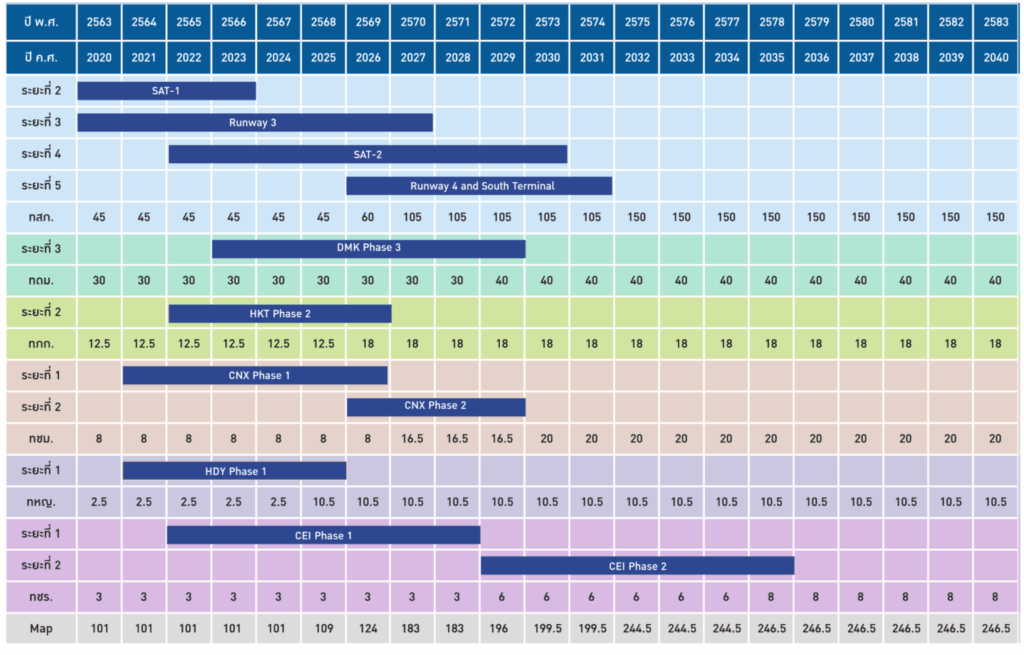
Unit: Million passengers per year
Note: The figures presented are based on future planning and may be subject to revision and adjustment as appropriate.
Sustainable Revenue
Satellite 1 Terminal Building (SAT-1)
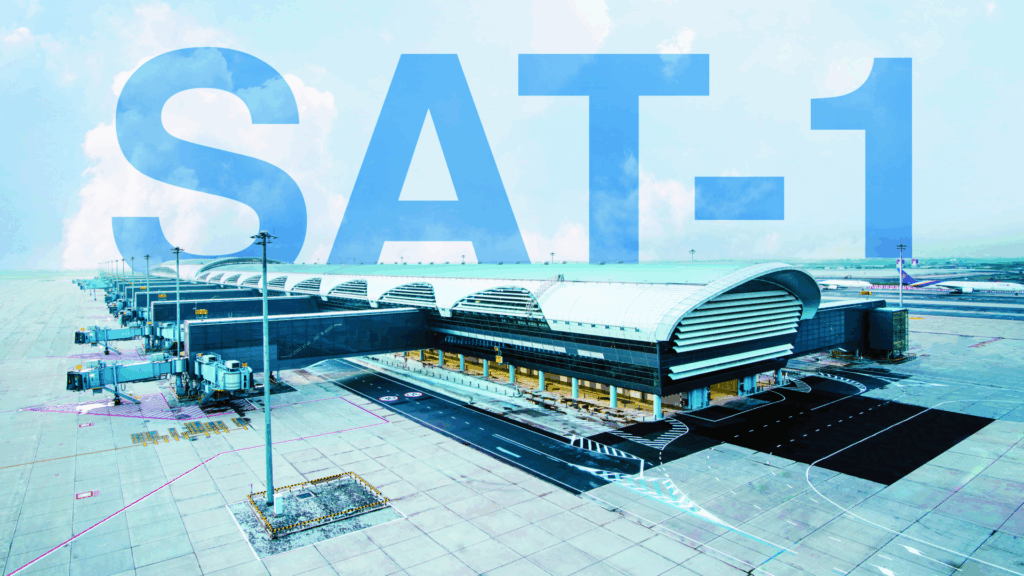
AOT has constructed Satellite 1 (SAT-1) as part of the Suvarnabhumi Airport Development Project, with an investment of approximately THB 39.76 billion. The purpose of this project is to expand the airport’s capacity to accommodate increasing numbers of international travelers and to alleviate congestion, raising Suvarnabhumi Airport’s passenger handling capacity from 45 million to 60 million passengers per year.
The SAT-1 terminal incorporates modern technologies to improve passenger experience, including the Automated People Mover (APM) system. AOT places strong emphasis on maintaining a high Level of Service (LOS) to ensure optimal comfort, convenience, and safety for all passengers.
SAT-1 includes 28 contact aircraft stands directly connected to the terminal. The building was designed with a strong focus on environmental sustainability, featuring sustainable architectural design, a wastewater treatment system for water reuse, natural lighting, heat-insulating materials, and solar panels to reduce energy consumption. These features align with AOT’s strategic plan to transform Suvarnabhumi Airport into a Green Airport that is environmentally responsible and energy efficient
Enhancing and Promoting the Use of Public Transportation for Convenient, Cost-Effective, and Environmentally Friendly Airport Access
AOT recognizes the importance of seamless ground transportation connectivity and has continuously developed airport ground access infrastructure in accordance with its Airport Development Master Plan. These efforts are carried out in collaboration with government agencies, state enterprises, and the private sector.
The initiative focuses on improving connections to city centers via various modes of public transportation, including public buses, taxis, and rail systems. Notably, Suvarnabhumi Airport and Don Mueang Airport are integrated with mass transit rail lines, offering passengers greater convenience, reduced travel costs, and lower environmental impact.
| Airport | Land Transportation | Rail Transportation |
|---|---|---|
| Suvarnabhumi Airport (BKK) |
|
|
| Don Mueang International Airport (DMK) |
|
|
| Phuket International Airport (HKT) |
|
|
| Chiang Mai International Airport (CNX) |
|
|
| Hat Yai International Airport (HDY) |
|
|
| Mae Fah Luang – Chiang Rai International Airport (CEI) |
|
|
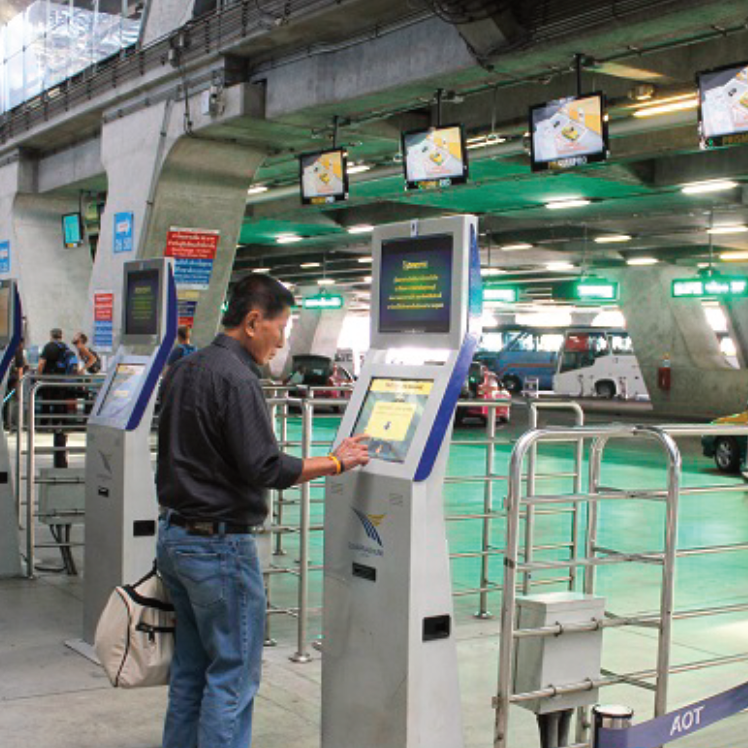
Accessible Smart Taxi Kiosks and Integrated Ground Transport Facilities at Suvarnabhumi Airport
AOT has installed automated taxi kiosks at Suvarnabhumi Airport that are accessible to persons with disabilities, supporting convenient airport access for all passengers. Facilitating seamless travel to and from the airport and enhancing integration with ground transportation systems are key factors in maximizing the efficiency and utility of national infrastructure.
To further enhance convenience, AOT has also implemented real-time intelligent display systems for public bus location tracking. These displays are installed in accessible areas and are designed to support use by persons with disabilities, contributing to a more inclusive and user-friendly travel experience at Suvarnabhumi Airport.
Freezone Smart Access Project at Suvarnabhumi Airport
AOT has implemented the Freezone Smart Access Project by installing advanced technologies to enhance access control and operational efficiency in the Free Zone area of Suvarnabhumi Airport. Key technologies deployed include facial recognition systems, license plate recognition cameras, and installations at Access Control (AC) checkpoints and Cargo Checking Posts (CP).
Additionally, ID Card Self-Service Kiosks have been installed to facilitate the issuance of temporary access permits for both individuals and vehicles, allowing access to the controlled Free Zone area for a period of up to 24 hours. These kiosks are designated specifically for issuing temporary personal and vehicle access cards.
This initiative aims to strengthen security, streamline access management, and improve operational efficiency between AOT and external stakeholders operating within the Free Zone at Suvarnabhumi Airport.
Airport Accessibility and Business Opportunity from External Development

Airport Accessibility and Business Opportunity from External Development
Sister Airport Agreement: SAA
Sister Airport Agreement (SAA) Partnerships
Since 2009, AOT has established Sister Airport Agreements (SAA) with international airport operators. As of now, a total of 14 organizations across 10 countries, covering 18 airports, have entered into SAA partnerships with AOT.
To ensure effective implementation, AOT holds annual high-level executive meetings with its SAA partners to jointly define the direction of collaborative activities and to exchange visions on airport management. In addition to formal meetings, AOT and its partner airports maintain ongoing information exchange through email correspondence and operational questionnaires, enabling mutual understanding and cooperation on a variety of operational topics.
These exchanges are aimed at strengthening marketing and tourism promotion, increasing air traffic and cargo volumes between AOT-operated airports and their SAA counterparts.
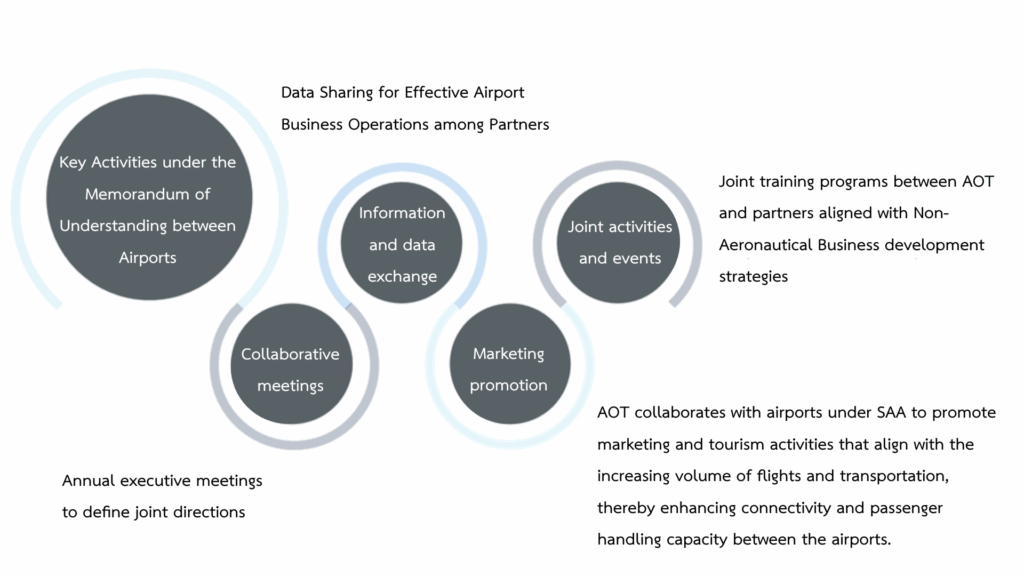
Identifying Investment Opportunities and Joint Venture Initiatives to Promote AOT’s Non-Aeronautical Business Development
To expand its non-aeronautical business potential, AOT has explored investment opportunities and the establishment of joint ventures through Memoranda of Understanding (MoUs) with international airport partners. These collaborations cover areas such as training, consulting services, joint ventures, and future-focused investment projects, which aim to deliver mutual benefits in terms of airport operational efficiency, financial capability, strategic partnerships, and enhanced leadership roles.
In the early stages, AOT focuses on delivering training programs that leverage its organizational strengths in key areas, including:
- Aviation safety and security
- Capacity enhancement to support business growth
- Crisis management and business continuity
- Development of non-aeronautical revenue streams
- Stakeholder engagement and management
These training initiatives serve as a strategic foundation for identifying and pursuing long-term investment opportunities. For example, AOT’s expertise in airport safety and security management can be offered through training collaborations, enabling partner airports to gain necessary certifications and operational readiness. This is essential for airports anticipating passenger growth and needing robust emergency response and security capabilities to meet international standards and business demands.
Proactive Engagement with Airports Council International (ACI) to Advance Global Airport Standards
AOT actively engages with Airports Council International (ACI), the global trade association of the world’s airports, to discuss and advocate for international standards in airport management. These standards cover passenger services, economic policies, environmental sustainability, and aviation safety and security.
ACI plays a vital role in promoting cooperation among airports worldwide and safeguarding the interests of its members and aviation stakeholders by developing global standards, policies, training programs, and sharing best practices in areas such as airport operations, information systems, security, and environmental management.
AOT has been a member of ACI since 1991, and has been honored to represent the Asia-Pacific region in knowledge exchange on critical topics such as airport safety and security, environmental management, economic development, human resource management, airport IT systems, and slot allocation. In addition, AOT has contributed to ACI’s COVID-19 task forces, helping to shape recovery strategies for the global aviation industry.
These leadership roles not only enhance AOT’s visibility and influence on both national and international levels but also strengthen business opportunities, market positioning, and AOT’s reputation as a leading airport service provider.
AOT publicly discloses its financial contributions to trade associations, both domestic and international, in its Sustainability Report each year to ensure transparency and demonstrate adherence to global best practices.
Furthermore, AOT evaluates its support for trade associations by considering each organization’s activities, objectives, and policy positions, particularly in relation to climate change. This includes alignment with global frameworks such as the Paris Agreement, and contributes to AOT’s efforts in advancing the climate change agenda through lobbying and trade association engagement (Climate Alignment).
Implementation
Key Projects Implemented by AOT (2024–2027)
In accordance with AOT’s internal project evaluation criteria, the following strategic projects have been implemented during the fiscal year 2024 (B.E. 2567). These initiatives drive operational excellence and align with AOT’s strategic indicators and corporate performance targets.
Major Projects:
- Don Mueang Airport Development Project Phase 3
- Construction of the 3rd Runway at Suvarnabhumi Airport
- Chiang Mai Airport Development Project Phase 1
- Phuket Airport Development Project Phase 2
- Suvarnabhumi Airport Development Project (Fiscal Years 2011–2017)
- Professional Supervision Program
- Air Cargo Transport Service Project: Regulated Agent (RA) Program
- Commercial Property Development Project (Property Development Roadmap)
- DMK Passenger Experience Zone Development Plan
- Phuket Airport Public Transportation Center Development Plan
- Feasibility Studies and Readiness Programs:
- Readiness Preparation for Surveillance by the Civil Aviation Authority of Thailand (CAAT)
- Feasibility Study for the Second Chiang Mai Airport (Lanna Airport)
- Feasibility Study for the Phang Nga Airport Project (Andaman Airport)
- Master Plan Review for Hat Yai Airport Development

